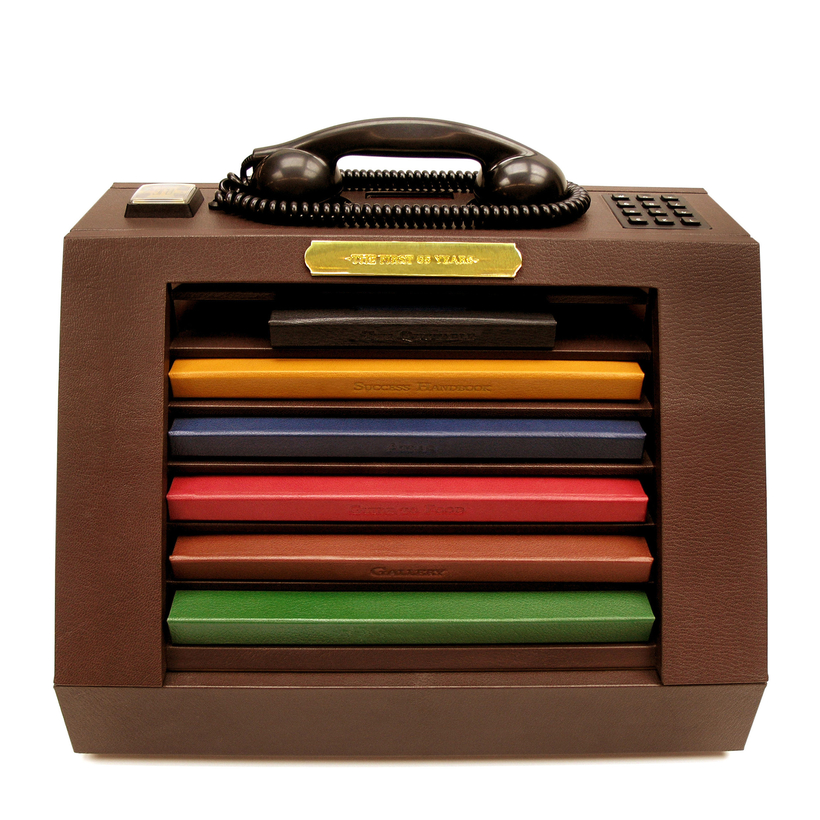Ask Michael Beneville what his namesake Beneville Studios does, and a sly smile appears on his face. “We’re in the magic business,” he says. Consult the clothbound folio that discreetly advertises the studio’s offerings, and it perpetuates, rather than reduces, the intrigue: “Michael Beneville creates … one-of-a-kind objects … for the world’s most discerning and exclusive clientele.”
In other words, it’s hard to generalize about this stuff. It’s “bespoke,” in the truest sense of the word. We’re not talking about tailor-made suits or shoes here, the uniqueness of which is simply a matter of your body or foot shape. We’re talking about a collaborative exercise that results in a creation in which clients can see themselves revealed. Most importantly, it’s quite literally one of a kind.

When Deborah Grubman wanted to give her husband, the music-industry attorney Allen Grubman, something special—and surprising—for his 65th birthday, she turned to Beneville. The goal: to tell the entire story of Grubman’s fascinating life, complete with the contributions of dozens of friends, in the most unique format imaginable. The result: a “memory console” that combines photography, audio and video recordings, and printed books, all focusing on different parts of Grubman’s life, from food to travel.
“I remember coming off that project thinking that in some great future we could all take the puzzle of ourselves and somehow put it in a box,” says Beneville, “so at some point in the future you could be resurrected.”
At which point it occurred to him that the Egyptians had beat him to the punch: what he’d made was a scaled-down pyramid. The studio had built a box, put a person in it, and covered the walls of it with that person’s story.
Breaking the Mold
When Beneville Studios creates an object for a customer, it prototypes that object, makes it once, and then breaks the mold. Every project starts from scratch.
“It’s a very ancient tradition,” says Beneville. “We’re just telling stories.”
Not to mention thrilling clients.

“It’s the most creative gift I have ever received,” says Grubman, “containing the greatest and most interesting moments of my life. What’s more, the people closest to me were able to speak to me in wonderful terms. I truly treasure it.”
He treasures it, but he’s not going to let you play with it. That’s the thing about the truly bespoke: it’s for one person—or one person’s family and friends—and no one else. They don’t come cheap, either: when you’re re-creating—reflecting—someone’s entire life, there are no corners to cut, no economies of scale. For another client, the studio created a collection of books and animation and film that documented 50 years of a man’s life, a massive effort that began with an entire year of interviewing that man’s family and friends and culminated with most of those people gathered on an island for four days. It should come as no surprise that the tab for such projects runs from six to seven figures.
The Power of O
Ask Beneville how he got started, and he points to the convergence of two towering influences: party planner Colin Cowie and Oprah Winfrey. In 2005, Winfrey asked Cowie to plan her Legends Ball, a three-day celebration honoring 25 Black women in art, entertainment, and civil rights, including Maya Angelou, Toni Morrison, Aretha Franklin, and Diana Ross. Cowie, in turn, asked Beneville to create a scrapbook commemorating the festivities, and inquired as to how long he’d need. Beneville’s reply: “I can give you something at the end of the weekend, or you can give me some time, and I will deliver something that you would deliver to a queen.”

Cowie gave him time, and Beneville took five months and told his team not to think about what they were being paid versus what the project was going to cost. The result was a highly engineered mechanical book that included pop-ups and windows that captured everything Winfrey herself might not have been able to see or process in the hubbub of the event. Cowie took Beneville with him when he presented the book to her. She cried and told him that he’d created an art form. That’s the moment that Beneville Studios was born. One of his first clients: Winfrey, who hired Beneville to do his thing all over again for her Leadership Academy for Girls.
“Michael is an extraordinary Renaissance man and a respected conceptual artist,” says Cowie. “I can only begin to imagine what lies ahead for him.”
As Beneville sees it, “for hundreds of years, people made bespoke objects for kings and queens, and then, one day, they got to make a cathedral,” he says. “There is no difference except for the scale.”

His latest obsession, virtual space, takes the concept even further. Using a proprietary platform he co-founded called Spatial Web, the studio can turn a walk down a hall of memories into something close to walking down an actual hall itself. Imagine being able to step inside your childhood home and open the drawers in your old desk. When Beneville feels a little heartsick for his deceased Yorkie, Oliver, he just boots up a scale version of Beneville Studios, heads on in, and gets to see and hear his beloved pup once more.
When I ask him about his favorite object, he demurs. “It’s not really about the objects, even though it is,” he says. “Of course, the client receives something at the end of the process, but, to a client, they will tell you that what they most enjoyed about the project was creating it.” In other words, what Beneville Studios sells isn’t one-of-a-kind objects but rather the creative process that results in those objects. Call it an idea-manifestation machine. Or you can just call it magic.
Duff McDonald is the author of Tickled: A Commonsense Guide to the Present Moment


